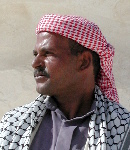Southwest from Cairo
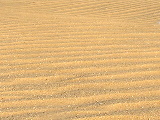
The Sahara. The name conjures up vast expanses of sand, camel caravans, and verdant oases. It practically defines “desert” so how could we go to Egypt and not spend some time getting at least a little taste of it?
“Baharia is 360 kilometres southwest, and we will stop at about half way. It should take us about 3 hours.” Hmm... that would mean an average of 120km/hour: I hoped our guide Mohamed Hussein was just being overly enthusiastic! It wasn’t quite that fast, but the road is straight and it sure felt like we were aiming for that kind of timing!
Green changes to desert as the road skirts the Pyramids in Giza, then passes several new “cities” being built to house the overflow of Cairo. Time will tell if people choose to move here: most of the complexes of multi-story buildings looked empty as we passed. The road follows the rail line built by the British in the 1930s, with evidence of water and oil pipelines, as well as microwave repeaters and power lines—all extending as a tenuous tendril of civilization into the increasingly barren desert.
The unnamed 180km rest stop was a welcome relief for everyone on the bus: just as well the facilities were needed urgently because one would not want to linger there! The scenery is pretty monotonous between Km180 and Baharia but Mohamed made the journey zip along with anecdotes, history and observations about modern Egypt.
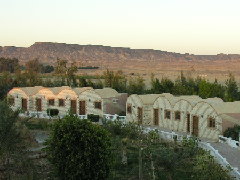
Baharia Oases is a large depression with several villages around the main town of Bawiti. All are dusty with few paved roads, and the buildings made mostly with mud or quarried white bricks covered with stucco. However, was not primitive: Bawiti’s main street has more than one Internet Cafe, and one of our group found she had reception on her Blackberry.
We stayed in the Palm Village Hotel just east of Bawiti in January 2007. Alhough it looked charming, and the beds were quite comfortable, they will need to resolve the cause of frequent power shortages and encourage their staff to smile a bit more to warrant the 3-star rating. The view of the desert and surrounding orchards from the upper deck gave us a real appreciation about how the desert just needs a bit of water to become green and productive.
Into the deserts...
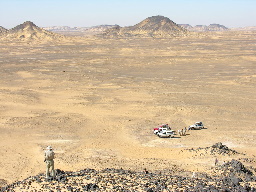
Our group bundled into the four 4WD vehicles after the drivers somehow managed to stuff our gear into spaces between tents, chairs and food. After a couple of brief stops at the Golden Mummies museum (several ornately-wrapped mummies in cases within a single room; interesting but very much in need of more explanation) and the Chapels of Muftilla (a series of small Pharaonic temples of the 26 Dynasty), we left Bawiti for the Black Desert.
This area is black because of volcanic activity, with lots of cinder cones and broken sheets of wind-eroded lava. Sweaters came off as the 6C morning temperature climbed up into the high 20Cs, and we could only imagine what it must be like in mid-summer when the mercury can pass 50C.
Just outside of the village of El Heiz, we stopped at the Ashour Cafeteria for a final bathroom break—and to add a few more plastic chairs to the already-loaded vehicles. Remembering the previous night’s chill, some of our group purchased camel hair gloves and vests as the rest of us sampled the thick and sweet mint tea.
With no discernable sign to alert us, the drivers turned off the highway, shifted down into 4WD and headed out through the sand towards some whitish hills. The drivers were obviously in their element now, as they each found different tracks across the flats at speeds I wouldn’t have thought possible in such deep sand.
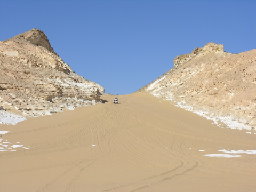
When our vehicle stalled making a sharp turn, we wondered if we would have to pack into the other machines, but after a few minutes consultation and much kidding by the other drivers, they got us restarted and we were off again.
Suddenly we came to the edge of an escarpment, with a long sandy hill leading down into the basin of the White Desert. The vehicles lined up and we all rushed down the slope to stop in the very welcome shade of a large formation for lunch.
Camel in the chalk
After lunch, we headed out into the White Desert. Why is it white? Some 45 million years ago, this area was part of a massive deposit of calcium carbonate (chalk) in a shallow sea. Layers of sand and volcanic material covered it, and water eroded the soft material to create caverns. The covering layers eventually collapsed, and windblown sand has eroded the remaining chalk into the formations seen today. Intermittent deposits amongst the soft rock contain remnants of ancient seabed sponges, shells and worm casings: the organic material replaced by minerals leached from the volcanic overburden.
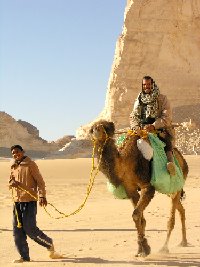
“Oh look, a camel!” Katharine called out and we all twisted to get a view. Being several kilometres from anything remotely civilized, it seemed unlikely, but sure enough, the indistinct figure out amongst the columns emerged as a man on a camel being led by his son. Although the photographers in every vehicle immediately called out for a photo stop, only ours complied; the others had to manage with “drive by shooting” as Hamada found some harder sand. Those of us with cameras bailed out of the vehicle and ran ahead to find the perfect location.
It must have been a very surreal scene for the camel: his desert reverie was suddenly interrupted by four 4WDs, a group of people ran out and pointed a range of devices at him, then scrambled back into the machines and disappeared…
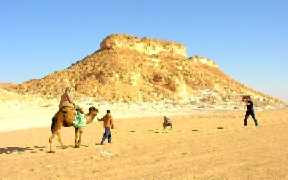
Our guide Mohamed explained, “These people are real Bedouins. They are probably traveling for days across the desert, and have everything they need to survive with them.”
Like the Bedouins, our drivers know the desert well. They followed tracks from earlier expeditions to some extent, but the wind quickly obscures even the deepest ruts so much of their navigation is from familiarity with the fantastical formations. We passed the spire, the treasure chest, the hippo… all weathered chalk amongst the sand. The drivers preferred the harder sand where the wind blew strongest, and avoided the leeward soft drifts.
Water for life
There was more vegetation than I’d expected, but our guide reminded me that the whole region was part of the oases, and water was often quite close to the surface. Indeed, as we pulled up near a tangle of date palms, the unexpected sight of green grass and water reinforced his point. The mini-oasis had an iron pipe with artesian water flowing out of it in a metre-deep excavation, and the overflow made its way down the hill to a small stuccoed tank. The date palms were short, and we were able to reach in amongst the sharp spines–very carefully–to sample fresh dates.
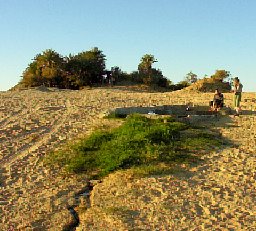
It was mid-afternoon, and a couple of the drivers rolled out mats to pray to the east. Such praying is very public; however, there was no sign of the discomfiture we would expect in our own culture. In fact, it was quite refreshing that they were so at ease with their faith that they could practise it in such a public–yet very matter of fact–way wherever they were.
The sun was getting low and our photographers were getting antsy for “sunset” shots. But first, an old acacia tree gripping a rock was on the agenda. All around it were the remains of what had been palms at a now-dry oasis; the acacia tree must have had deeper roots to manage to hang on–but it was clearly losing the battle.
With only minutes to sunset, everyone piled into the 4WDs and each driver found his own route to the chosen spot for our view. While the photographers were anxious about the declining light, everyone else’s anxiety was more focussed on hanging on as the drivers made a mad dash to some rocks at the edge of an escarpment. With only moments to spare, we tumbled out and ran for a position: but alas, the sun slipped down with a pretty but not spectacular sunset.
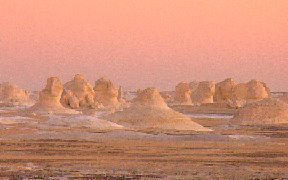
“Don’t worry,” photographer Gary Crallé advised, turning his lens to the field of chalk mounds to the south. “The light will be perfect soon!” He was right: the mounds glowed with an apricot hue, then slowly faded to ghosts against a purple sky. The sound of slow shutters was all that broke the silence for a while.
Saharan night
Our camp location was only a few minutes away, and the drivers expertly positioned two vehicles nose-to-nose with the other two forming flanks on the sides. This arrangement made perfect sense minutes later as they unfurled colourful heavy cloth to hide the machines–and provide a welcoming shelter against the evening breezes. As we helped erect and position the tents, our drivers prepared a feast of barbecued chicken and lamb on a savoury bed of rice with vegetables. Low tables were set up on a long carpet on the sand and everyone discovered that the clean air had given us more of an appetite than we might have thought.
The Saharan sky is like no other: clear and immense, it cloaked us as we sat around the fire chatting. Our guide noted that the Arabic calendar is based on the 28-day lunar month–probably in part because night offered better reference points for navigation during the often featureless daytime, but also because travel at night would be cooler. Even with a quarter moon, the stars were intensely bright, and it was easy to imagine camel train navigators using their light as they plotted their course across the desert.
It was cold that night–around 6C. Some of our group felt quite chilly the next morning because they’d made the mistake of bundling up in extra clothes before getting into their sleeping bags: body moisture absorbed by the clothing during the night drew the cold in against their skin when they got out in the morning. Lightweight silk longjohns will be included in future packing!
Daybreak
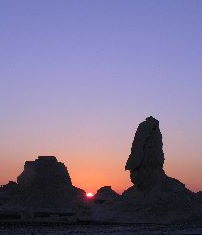
The morning more than made up for any disappointment about the sunset. Katharine and I were up well before dawn–but distant shapes amongst the chalk let us know we weren’t the first ones. The sky changed from indigo to rose as the sun came up, and even the first direct rays showed the promise of the heat to come. The light at the edges of the day is even more photogenic in the desert than normal, and everyone was soon out taking pictures and marvelling at the abundant fossils in the chalk surrounding our camp site.
We were brought back to the camp by the smell of coffee–albeit only the ubiquitous Nescafé instant we’d found everywhere in Egypt. Our drivers had prepared yet another great meal, and as we finished off fruit and yoghurt, they dismantled the camp. We were off by 10.
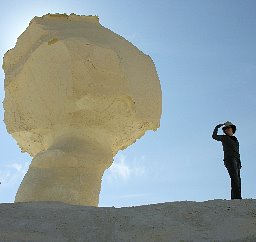
More shapes. Although the mushroom looked as if it couldn’t possibly remain standing much longer, Hamada assured us it hadn’t changed for years. Nonetheless, we all took lots of pictures just in case!
When Gary wanted to get a long shot of the other vehicles, Hamada was happy to oblige and turned up onto what looked like an impossible route over rutted beds and large boulders of chalk. We all hung on to anything we could as we bounced along to the edge of a cliff and an excellent view of the other three vehicles making their way through the valley below.
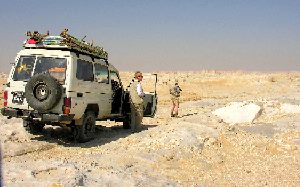
As Gary got his shots, I noticed Hamada peer over the edge: surely he wasn’t going to take us down there? Sure enough, with a whoop, he dropped it into the lowest range and inched us over the edge! Everyone’s hands were gripped on whatever was solid as we tipped forward, but Hamada knew what he was doing and we were soon down onto a more normal surface and racing along to catch up to the others.
Alas, the next stop was our last amongst the chalk: the track was more defined here, with rocks placed to channel vehicles to the nearby highway. Tony explained that this was the “old” White Desert (as opposed the “new” White Desert where we’d camped), and it would all eventually become a protected area. Just as well: for the first time, we could see the lingering effects of overuse, with distinct tire marks on the rock and evidence of rock hammers having been used to chip out fossils. We pulled out onto the highway and turned north back towards Baharia.
“Lunch at the crystal mountain!” Hamada called out as we climbed the rise to take us out of the Farafra Depression. The formations were greyer now, and the desert floor had more stony areas. When the lead vehicle pulled off the highway, each of the ones behind turned too and we made our way in parallel across the flats to a gap in the hill in the distance. Although it looked similar to what we’d seen earlier, the rock in this area was full of quartz intrusions, and exposed parts glistened like jewels as the sun was reflected of faceted sides.
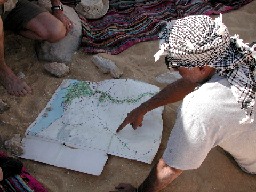
As we explored the crystalline formations, and relaxed in the shade, our drivers took time for prayer and then prepared yet another excellent hot meal. (Where was all this food coming from anyway?) One of our very well-informed guides, Tony Mehsen, pulled out a detailed map and answered questions about the regions we’d been exploring.
All too soon we were back into the vehicles. The hills around the Baharia Oases appeared sooner than expected, signalling a close to our desert adventure. The Palm Village Hotel seemed cosier than before, and by dinnertime, everyone was showered and feeling reflective.
It was an early night for most of us, but I lingered on the roof patio to get a final view of the Sahara at night. The stars hung as silent witness to the timelessness of it all: trains of camels had been passing through this oases since before the time of the Pharoahs. Our 4WD conveyances and high tech gadgetry merely made the passage quicker and perhaps more comfortable than what they would have experienced.
Would I return? Definitely–and next time I’d be keen to sign up for a longer trek by camel!

